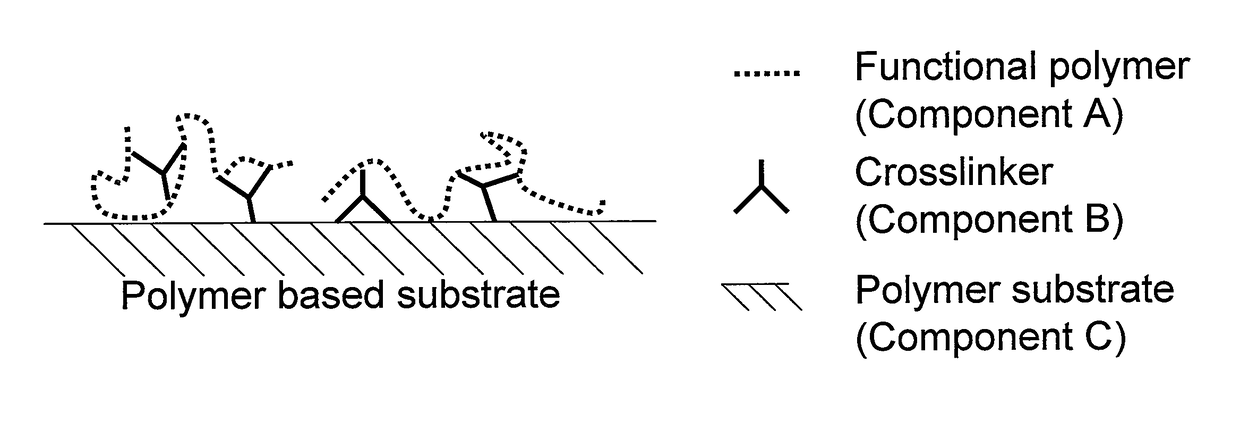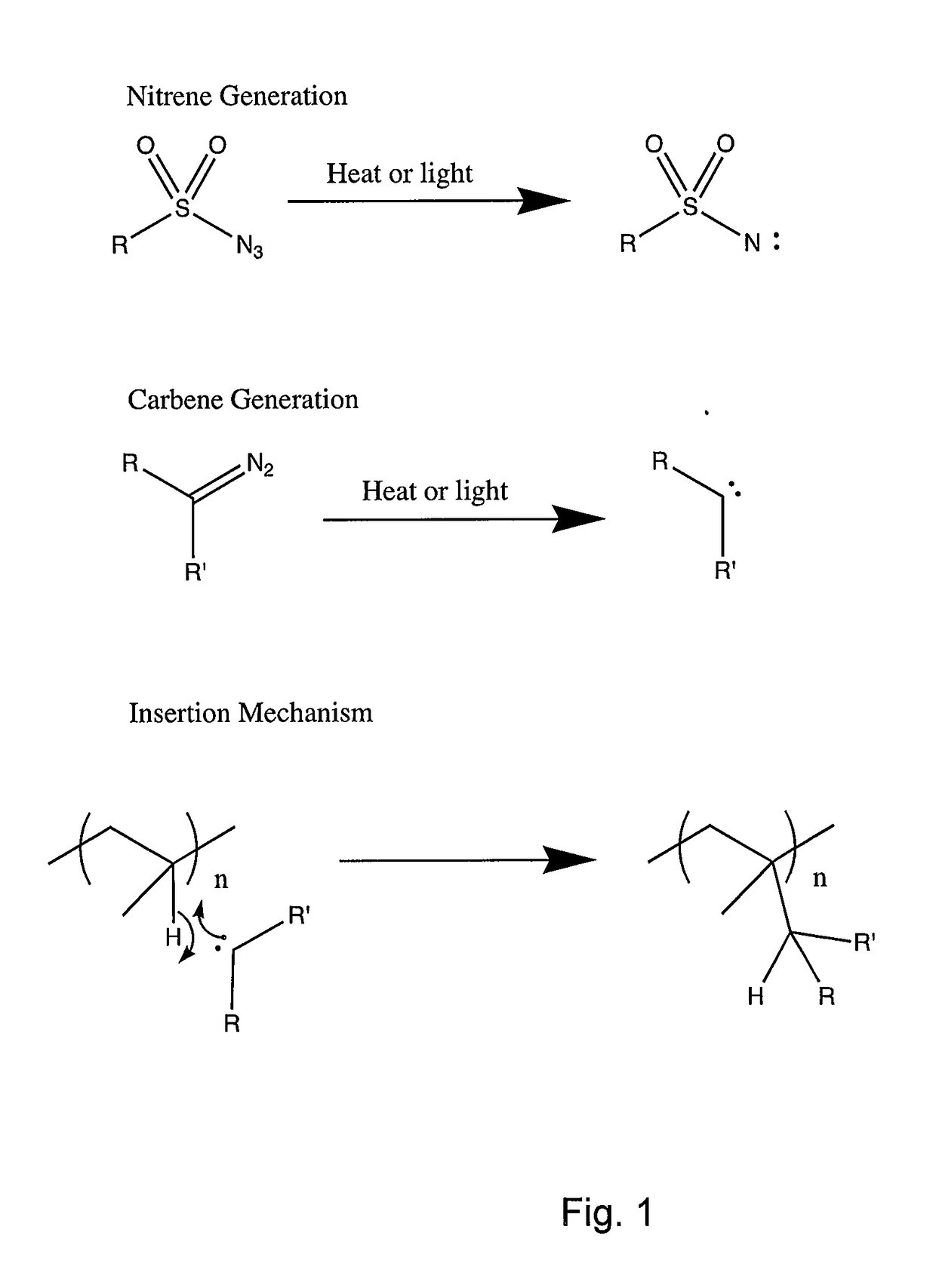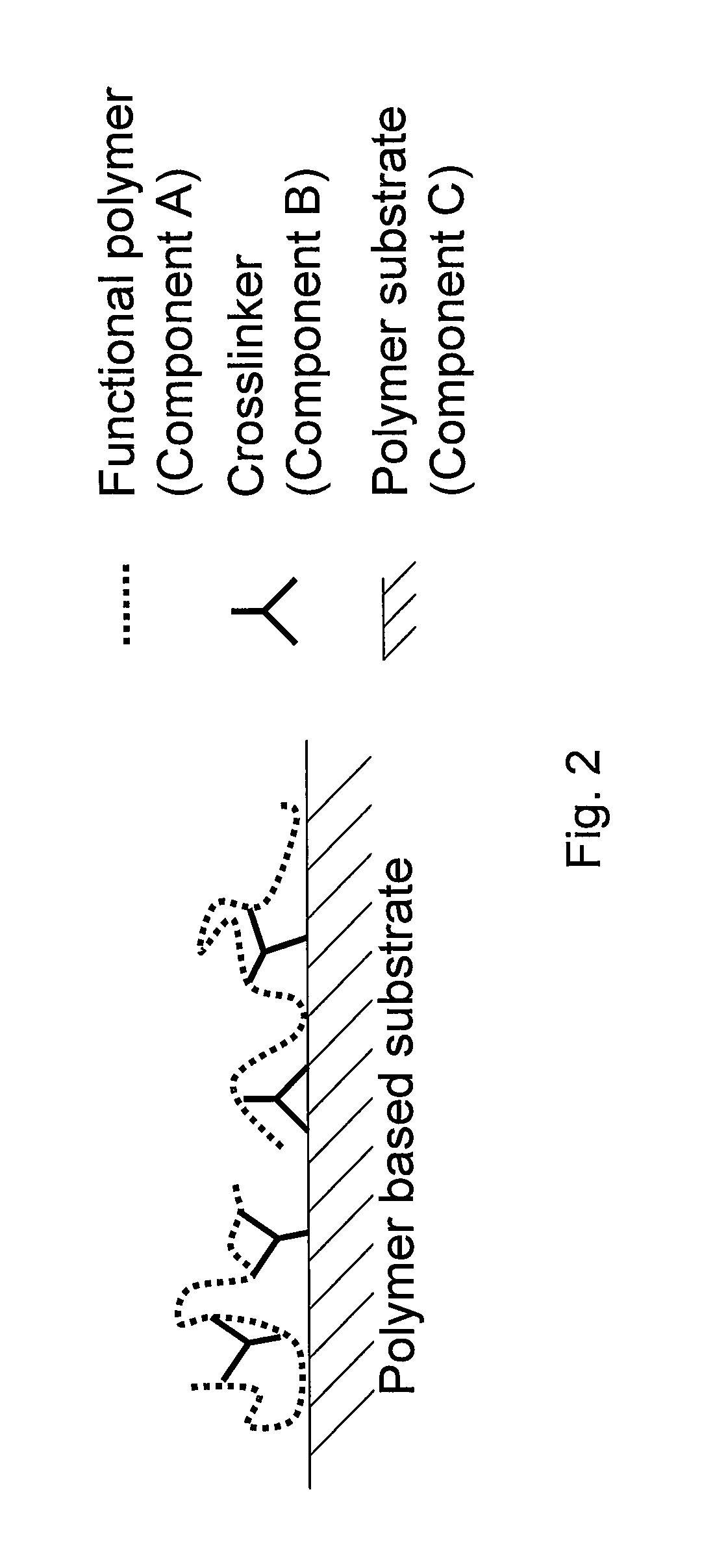[0010]The chemical reaction of a modified functionalized polymer A-B that has a specific chemical functionality with the polymeric surface of the substrate would result in a permanent modification of the polymeric surface of the substrate. More specifically, reacting functionalized component A with modifier component B can generate a modified functionalized polymer A-B which is capable of acting as an adhesion promoter / demoter agent which then can chemically bond to the surface of the polymer substrate and change the surface energy of the polymer substrate leading to enhanced adhesion properties in adhesive or lamination applications.
[0011]Still more specifically, the modified functionalized polymer A-B can covalently modify a polymer substrate which has a lower or higher surface energy that counteracts the direct attachment of functional component A. More specifically, modified functionalized polymer A-B can modify the polymer substrate which has a polarity that limits and / or prevents the direct attachment of functional polymer A. More specifically, the modified functionalized polymer A-B can modify the polymer substrate which has a surface that is hydrophilic or hydrophobic which can limit and / or prevent the direct attachment of functional component A. Still more specifically, modified functionalized polymer A-B can modify the polymer substrate which has a surface that is oleophilic or oleophobic which can limit and / or prevent the attachment of functional component A.
[0012]Yet more specifically, the modified functionalized polymer A-B can modify a polymer substrate by changing its surface energy. More specifically, the modified functionalized polymer A-B can be used to increase or decrease the effective surface energy of the polymer substrate to improve its compatibility with, for example, coatings, materials, adjoining layers, or the like.
[0016]In accordance with at least selected possibly preferred embodiments of the invention, chemical modification of at least a portion of the surface of polyolefin microporous separators or membranes can be accomplished by the functionalized polymer A containing the carbene and / or nitrene intermediate with, for example, the carbon-hydrogen bonds of the polyolefin. This chemical reaction or treatment based on functionalized polymer A (component A or functionalized component A) containing the carbene and / or nitrene intermediate provides a method of more permanently improving the wettability of polyolefin microporous separators in lithium-ion rechargeable batteries. In addition, the preferred reaction of functionalized polymer A containing the carbene and / or nitrene intermediate with the C—C and C—H bonds in at least a surface layer of polyolefin microporous separator membranes can be used to introduce a crosslinking functionality into the polyolefin which can be used to improve the high temperature stability of the polyolefin microporous separators or membranes.
[0017]In accordance with at least certain selected embodiments, the present invention addresses the need to modify the surface of porous polymeric substrates. At least selected embodiments of the present invention address the above need and are directed to modified porous polymeric membrane substrates, methods of making modified polymeric porous membrane substrates, and methods of using modified polymeric porous membrane substrates. More particularly, the invention is directed to chemically modified polyolefin microporous membranes, methods of making chemically modified polyolefin microporous membranes, and methods of using chemically modified polyolefin microporous membranes. Still more particularly, the invention is directed to chemically modified polyolefin microporous waterproof / breathable textile membranes, methods of making chemically modified polyolefin microporous waterproof / breathable textile membranes, and methods of using chemically modified polyolefin microporous waterproof / breathable textile membranes. In accordance with at least selected preferred embodiments, the invention is directed to chemical modification of polyolefin microporous waterproof / breathable textile membranes by the reaction of the modified functionalized polymer A-B which contains the carbene and / or nitrene intermediate with the carbon-hydrogen bonds of the polyolefin, methods of decreasing the surface energy or imparting oleophobicity to waterproof / breathable textile membranes to improve the fouling resistance of waterproof / breathable textiles and / or improve the durability of the membranes' waterproofness, and / or the like.
[0018]In accordance with at certain selected embodiments, the present invention addresses the need to modify the surface of polymeric textile fibers. At least selected embodiments of the present invention address the above need and are directed to modified polymeric textile fibers, methods of making modified polymeric textile fibers, and methods of using modified polymeric textile fibers. More particularly, the invention is directed to chemically modified polyolefin textile fibers, methods of making chemically modified polyolefin textile fibers, and methods of using chemically modified polyolefin textile fibers. In accordance with at least selected possibly preferred embodiments, the invention is directed to chemical modification of polymeric textile fibers by the reaction of the modified functionalized polymer A-B which contains the carbene and / or nitrene intermediate with the carbon-hydrogen bonds of the polymeric textile fibers, methods of decreasing the surface energy or imparting oleophobicity to polymeric textile fibers to improve the fouling resistance of polymeric textile fibers and / or improve the durability of the textile fibers' waterproofness, and / or the like.
 Login to View More
Login to View More 


